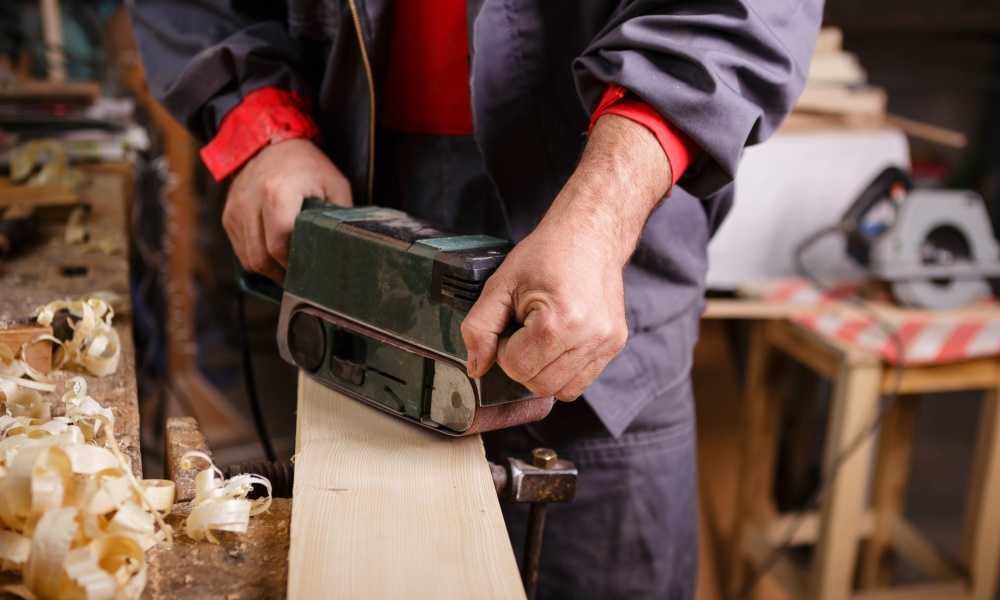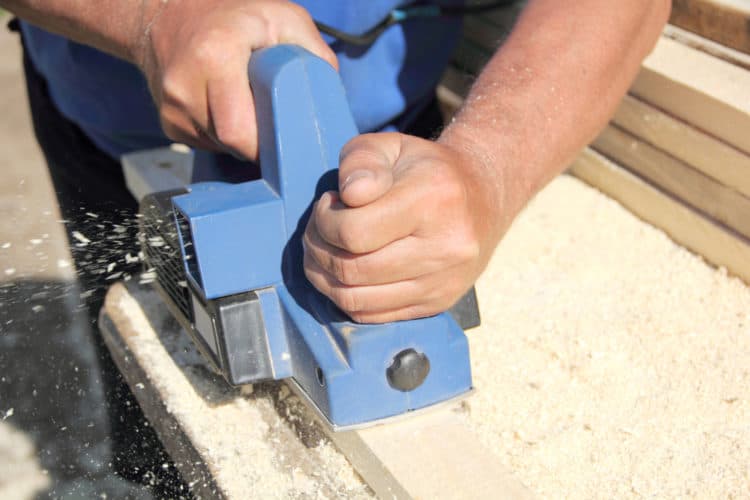Belt Sander Vs. Planer: Which One To Buy?

If you’re planning to tackle a project where you’ll either have to remove slices of wood or varnish from a surface, you might get stuck choosing between a belt sander vs. planer.
Although a beginner to woodworking might assume that both tools perform the same function, this is a common misconception and choosing one over the other could make a big difference to your results. If you’re deciding between a belt sander and a wood planer, use this guide to help you learn about the differences between the two and the benefits of each.

What is a Belt Sander?
Considered one of the most useful tools in a woodworking kit, a belt sander helps you to remove imperfections from a surface such as drywall, but more specifically wood.
A sander is a phenomenal tool to have at your disposal when you’re interested in refinishing a piece of wood to fix improper staining or deterioration over time. It is specifically designed to help you get the job done quickly, as it is equipped with a motor that powers a loop of mounted sandpaper.
Belt sanders may seem to be relatively simple to use, and they are once you have experience, but they also come with a lot of power under the hood.
They’re incredibly aggressive and if you’re not careful, you can remove too much material, causing you to spend more time creating a perfect base for finishing. It’s always best to start a project with a belt sander and then finish it off with a detail sander.
A couple of great benefits of a belt sander include:
- Fast and Efficient: Above all else, a belt sander is designed to help you tackle big projects much faster than you could imagine, which is what makes it more difficult for beginners to use. Due to the fact that it is incredibly powerful, you might find that you’ll have to pay special attention to how much material is being removed with a single swipe. However, once you have an idea of how your belt sander works, it can easily become your best friend for time-sensitive projects.
- Large Surface Area: There are typically different sizes of belt sander that you can choose from, but it’s recommended that you opt for models that have the largest surface area as they are the easiest to handle. The larger the area, the less you’ll have to go over the same spot twice which helps prevent any imperfections.
- Teaches Skill: Another interesting benefit of a belt sander is that it helps to teach a skill that you wouldn’t be able to learn with other tools. As with any type of equipment, there is a learning curve to tackle, and once you get your hands on a belt sander, you’ll learn more about the importance of balancing tools.
Our Top Recommended Belt Sander
Makita 9403 Belt Sander
When you look for the best belt sander, you may find a lot of options out there that fit what you are looking for. For us, when we are looking for that perfect choice, there is none better than the Makita 9403. We think you should look at all the amazing features and benefits you will be able to take advantage of if you go with this fantastic belt sander.
Review
This model is great for those that may be working on prep work like removing paint, or someone who deals with raw lumber quite a bit. These projects are all enhanced with the features that this model has built into its design.
These features include:
- Enhanced auditory safety with a reduced noise level (84 dB)
- Improved material removal (1640’ per min.)
- Expanded belt width (4”)
- Protected motor and bearings with labyrinth construction
- Ergonomically designed for better comfortability
Built to optimize the efficiency and performance of all your woodworking needs, this quiet, easy-to-use belt sander is simply the best that we can find, and that is why it is our top recommendation.
Pros
- Crafted with high grade and durable materials
- Designed to be ergonomic with front and back handle layout
- Built-in 11 Amp motor with speed control technology
- Easy to change sanding pads
- Enhanced sanding belt for optimized efficiency
- Compatible with a wide range of paper grits
- Reduced noise levels
- Dust bag is adjustable in a 360-degree radius
Cons
- Price is a bit high
- Lack of variable speed control

What is a Planer?
If you’re working on a project that requires you to make a level surface, you’re more likely to rely on a Planer (do you wish to know what hand Planer is? click here) than a belt sander, especially as planers are specifically designed to remove slivers of wood with every pass. Belt sanders are better for removing finishes rather than trying to create a uniform level across the wood.
check our review on the best best wood planer here
Depending on the projects you’re faced with throughout your home, it can be beneficial to own a planer as it helps you to make small and large adjustments with ease, especially when it comes to doors, cupboards, and/or shelves. For example, if a door in your home is slightly too large to fit into its frame, you can easily use a Planer to adjust the width of the wood.
If you want something user friendly, most people would suggest that you invest in a Planer because it’s much easier to control and doesn’t have as much of a learning curve.
A few of the most main benefits of a Planer vs. a belt sander include:
- Straight and Uniform: The biggest benefit that a Planer has over a belt sander is the fact that it makes it much simpler to create straight and uniform cuts with every pass. Until you have experience with a belt sander, you’re going to notice plenty of shallow and high spots on the wood due to how you hold the tool. However, with a Planer, you don’t have to be perfectly uniform in your passes in order to create an even surface.
- Cost Effective: Another advantage of a planer is that it is a one-time investment, aside from blade replacements and sharpening (check out how to sharpen planer blades), whereas with a power sander you’re responsible for buying replacement sandpaper. There are plenty of professionals who prefer not having to worry about purchasing additional accessories in order to have their tools work.
- Smooth and Even Finishes: Above all else, using a planer or benchtop planer gives you the ability to have smooth and even finishes at the end of every pass. Unfortunately, there are plenty of people who still experience a certain gritty texture on the surface of their wood, even after using a belt sander. If you want a flat and even surface, a Planer could be the best option.
Our Top Recommended Planer
DEWALT DW735X Planer
Having all your boards the same thickness is vital in any woodworking project, and that means that you will need a good Planer. There are many options out there, but the one we feel is the best on the market is the DEWALT DW735X. Designed and constructed with the professional in mind, this model offers a lot of great qualities that will only enhance your overall productivity and performance.
Review
This stationary Planer can be a great addition to your tool kit. Especially if you are often working with raw lumber and want to ensure consistency in your wood planks. There are so many great attributes that this Planer has, and some of those are:
- Enhanced cutter head speed (10,00 RPM)
- Built with a high powered 15 Amp motor (20,000 RPM)
- Designed with multiple knife cutter-head (3)
- Crafted with a fan-assisted waste removal system
- Optimized efficiency with a two-speed gearbox (96 – 179 CPI)
- Increased cut depth (1/8” – 6”)
- Extended width cutability (13”)
- Extras: infeed table, outfeed table, extra knives
- 14’ per minute drop feed rate
This is our top recommendation because of the level of versatility and performance it offers. That paired with the longevity of use simply makes this one of the best planers on the market today.
Pros
- Extended knife life from the high-quality cutter head
- Easily cuts wide materials
- Comes with replacement knives
- Great for any level of experience
Cons
- Issues with noise levels
- Price is a little high for some
FINAL VERDICT
Choosing between a belt sander vs. Planer is simpler than you think as long as you have an idea of what your project is. With that being said, both tools are great for different tasks and as such, you may want to consider investing in both.


